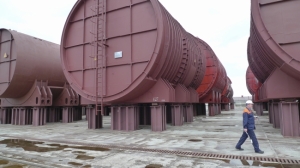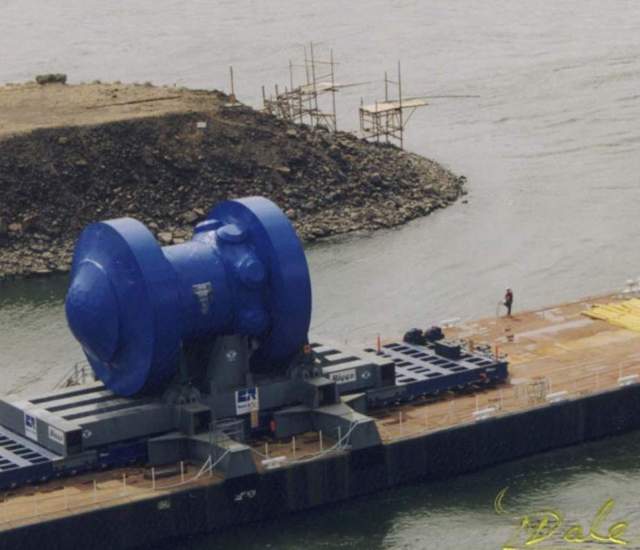Introduction
I just read an interesting article about an arctic environmental problem being presented by a Soviet-era nuclear submarine that had been scuttled back in 1982 (Figure 1). Apparently, scientists are now concerned that the submarine's reactor could leak dangerous fission products into the ocean. There is even some concern that an uncontrolled nuclear reaction could occur at this wreck that could be a serious environmental problem.
The article contained the following quote that got me thinking about the amount of fuel that a nuclear submarine's reactor must carry.
The K-27 was scuttled of the coast of Novaya Zelmya in 50 meters of water in 1982. It contained 90 kilograms of uranium-235 when it went down.
Let's see if we can estimate the amount of uranium-235 (235U) that a submarine reactor must carry to do its job over its working lifetime.
Background
I am going to include some information that is not needed for my analysis, but that I found interesting because I have never thought about large these reactor plants are and how they are disposed of when they are spent.
Analysis Information
The following information is needed for my analysis. Some of the numbers are going to be crude guesses, but I am only interested in an estimate. I will focus on the S6G reactor used on the Los Angeles class boats because I can find the most information on those power plants.
- Energy per Fission of 235U Atom.
Wikipedia states that each fission produces 202.5 MeV of energy.
- Molar mass of 235U.
The Wikipedia states that the molar mass of 235U is 235.043 grams.
- Efficiency of the power plant.
I am going to guess 25% because that is a figure I have seen quoted for other steam turbine-based power systems.
- Average power usage during the lifetime of the submarine.
Submarine power plants are typically rated at 35 khp to 50 khp (khp = 1000 horsepower). I will assume that on average they use 15 khp while at sea.
- The average operational duty cycle (i.e. ratio of on-station time to total time).
I have seen 86% quoted, so I will use that number.
- Hotel load of the submarine.
Not all the power generated by the reactor goes into propulsion – some goes into electrical power used for all the equipment on-board. This load is referred to as the "hotel load". For cruise ships, this load is about 50%. I am going to guess that a submarine's average hotel load is 25%. Here is a forum post that uses 30% – like me, he is guessing.
- Time between refuelings.
I will estimate 10 years (source).
Reactor Size
Figure 2 shows a cut-away diagram of a submarine. You can see the reactor section towards the aft of the boat.
Figure 3 shows the reactor from the USS Tecumseh, a James Madison-class boat. This class of submarine is earlier than the Los Angeles-class, but you can get a feel for the size of these reactors by comparing its size to the man on the right-side of the dock.
"Proper" Disposal
According to Lloyd's Register, there are "about 200 nuclear reactors at sea, and that some 700 have been used at sea since the 1950s". While people debate what about the proper way to dispose of old reactors, virtually everyone agrees that dumping them in the ocean is the wrong way to do it. As is shown in Figure 4, both the US and Russia today use on-land storage for decommissioned reactors (a-source, b-source).
 |
 |
| Figure 4 (a): On-Land Storage of Decommissioned Russian Submarine Reactors. | Figure 4 (b): On-Land Storage of Decommissioned US Submarine Reactors (1994). |
Analysis
Figure 5 shows my calculations. Remember – I had to estimate some key parameters to obtain my result.
I estimate that about 200 kg of 235U is in each reactor at the start of its life. This amount will reduce throughout its lifetime. At some point, the percentage of 235U will reduce to a point where the reactor is not efficient anymore.
Conclusion
My estimate of 200 kg of 235U for a submarine agrees with the following quote that I found in this article. As I understand it, this number was generated by taking the total amount of 235U dedicated to US naval reactors per year and dividing that total by the number of reactors.

Figure M: Quote from a Paper That Derives Average Uranium Load Per Reactor Using Alternative Approach.





THABK YOU FOR SUCH GREAT INFORMATION... MY FRIEND SERVED ON THE JAMES MADISON... SINCE HE HAS WORKED AS A CLAMMER AND RESIDES IN New Jersey...
THANKS AGAIN,
Madelyn
does one thumb down and one thumb up mean my comment was not great....
Your comment is just fine. Thanks for leaving a note.